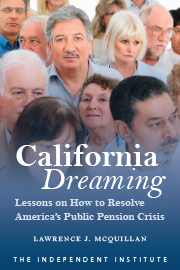The kids are back in school, and many California parents are tallying up the costs of the new clothes, shoes and school supplies. But the real sticker shock will come from soaring teacher pension costs that will devour school budgets for decades to come.
California public school teachers are members of the California State Teachers’ Retirement System (CalSTRS), a “defined-benefit” pension system that guarantees retired teachers a specific monthly benefit for life. The amount is determined by a formula that considers each teacher’s final compensation, years of service and retirement age. Unfortunately, CalSTRS doesn’t have enough money to pay for the promised benefits.
The gap between CalSTRS’ obligations and assets runs between $74 billion and $104 billion, depending on accounting assumptions. To pay for the benefits earned for work already performed, this money should be in the bank today, earning compounded returns.
In response to this gaping deficit, the Legislature passed Assembly Bill 1469 last year. The measure, signed by Gov. Jerry Brown, requires the state of California, public school districts and teachers to contribute more into CalSTRS.
Teachers’ contribution rates will increase from 8 percent of their pay in 2014 to as high as 10.25 percent by 2016, a 28 percent increase. School districts will be hit harder, with the contribution rate rising from 8.25 percent of payroll in 2014 to 19.1 percent by 2020, a 132 percent hike.
While the increases may save the pension system from financial disaster, pouring additional millions of dollars into CalSTRS will leave school districts with less money to hire teachers, repair schools, and provide for the classroom needs of children.
One exasperated school official in Marin County said, “I have no idea where we’re supposed to get the money” for the ballooning pension payments. Marin is the wealthiest county in the state.
Using data on “creditable” compensation (without adjustments or inflators) from the Marin County Office of Education, annual pension payments from Marin County school districts will increase from roughly $15 million in 2014 to at least $36 million in 2020.
Under the AB1469 scheme, these higher pension payments will hit all school districts statewide for 32 years, until 2046. A new Moody’s report shows that aggregate contributions from local school districts will increase to $6.4 billion in 2021 from $2.3 billion in 2015, a nearly threefold increase.
The history of CalSTRS is one of politicians overpromising benefits, underfunding contributions, and pushing mountains of pension debt onto future generations. California schools and taxpayers are now stuck bailing out CalSTRS for the reckless mismanagement.
When politicians and bureaucrats compromise education to bail out an obviously broken pension system, a moral tipping point is reached. You can see the predictable results in Chicago, where the Chicago Public Schools system laid off 500 teachers and more than 1,000 support staff in August in response to out-of-control pension costs and a $10 billion unfunded liability. California is heading for a similar meltdown.
The Golden State must gain control over its skyrocketing teacher pension costs by following the lead of other states and switching to 401(k)-style pensions for teachers and other public employees.
These are the type of “defined contribution” pension plans most private-sector workers have. Benefits can be adjusted up or down annually based on economic and market conditions.
Because government wouldn’t be locked into long-term, uncertain funding commitments, California could cap its unfunded pension liability and produce significant budget savings, which should be used to pay off the CalSTRS debt quickly.
This would spare our children and grandchildren from the pension pain that schools and parents are feeling today.









